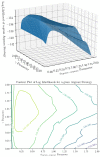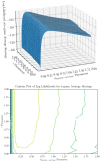Inferring an Observer's Prediction Strategy in Sequence Learning Experiments
- PMID: 33286665
- PMCID: PMC7517522
- DOI: 10.3390/e22080896
Inferring an Observer's Prediction Strategy in Sequence Learning Experiments
Abstract
Cognitive systems exhibit astounding prediction capabilities that allow them to reap rewards from regularities in their environment. How do organisms predict environmental input and how well do they do it? As a prerequisite to answering that question, we first address the limits on prediction strategy inference, given a series of inputs and predictions from an observer. We study the special case of Bayesian observers, allowing for a probability that the observer randomly ignores data when building her model. We demonstrate that an observer's prediction model can be correctly inferred for binary stimuli generated from a finite-order Markov model. However, we can not necessarily infer the model's parameter values unless we have access to several "clones" of the observer. As stimuli become increasingly complicated, correct inference requires exponentially more data points, computational power, and computational time. These factors place a practical limit on how well we are able to infer an observer's prediction strategy in an experimental or observational setting.
Keywords: Bayesian models; prediction; sequence learning; stochastic processes.
Conflict of interest statement
The funders had no role in the design of the study; in the collection, analyses, or interpretation of data; in the writing of the manuscript, or in the decision to publish the results.
Figures






References
-
- Hohwy J. The Predictive Mind. Oxford University Press; Oxford, UK: 2013.
-
- Von Helmholtz H. Handbuch der physiologischen Optik: Mit 213 in den Text eingedruckten Holzschnitten und 11 Tafeln. [(accessed on 1 July 2020)];1860 Available online: https://books.google.co.uk/books?hl=en&lr=&id=4u7lRLnD11IC&oi=fnd&pg=PA8....
-
- Attenave F. Applications of Information Theory to Psychology: A Summary of Basic Concepts, Methods and Results. Holt-Dryden Book; New York, NY, USA: 1959.
Grants and funding
LinkOut - more resources
Full Text Sources
Research Materials

